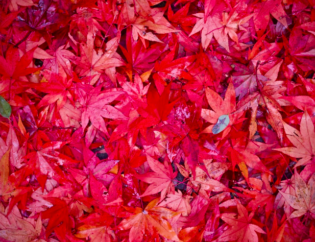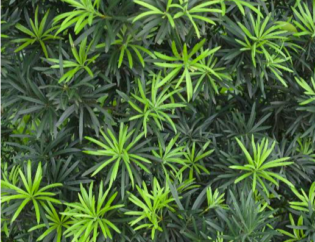When it comes to blooming shrubs, there aren’t many other tougher, longer living shrubs that have appealed to generation after generation than Lilacs. These hardy shrubs thrive here in California’s Central Valley. They tolerate (almost prefer!) the low humidity and high heat of our growing season. Lilacs are frost tolerant and in fact require “chill hours” to bloom well. The only drawback to these resilient shrubs is that they typically only bloom once per year…well they used to (more on this below)! All lilacs are pollinator friendly. Their nectar attracts bees, hummingbirds and butterflies.
Old Favorites
These varieties have been around for decades and are long lived, often living over a century! They bloom once per year and make great cut flowers too.
Sensation – introduced in 1938, this is our most popular variety. Each small dark purple flower is edged by white, offering a stunning display. It is strongly fragrant too!
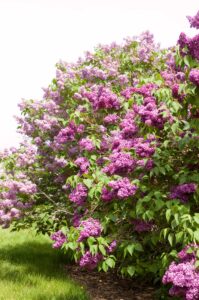
Monge – introduced in 1913, it is known for it’s large panicles (clusters) of reddish-purple flowers and classic fragrance.
Ludwig Spaeth – introduced in 1883, it is known for it’s dark purple flowers. It is a late bloomer for a lilac so add it is a great addition to extend your lilac display. Heavily scented. Interesting fact, this variety is often used in firescaping to reduce vulnerability to wildfires.
Charles Joly – introduced in 1896 and known for it’s richly magenta-purple double flowers. Strong, sweet scent.
Beauty of Moscow (Krasavitsa Moskvy) – introduced in 1943. Another late season bloomer with light pink buds that open to double white flowers. Long lasting flowers with scent that becomes stronger as the blooms age.
New Favorites
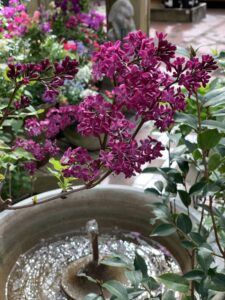
Old Glory – introduced in 2006 by the United States National Arboretum. Bred to resist powdery mildew in humid climates. Purple-blue flowers have classic lilac fragrance. Grows 8-11′ tall and 10-12′ wide.
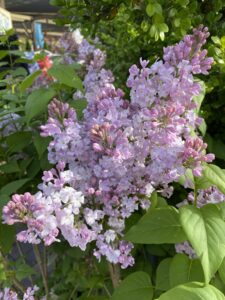
Lavender Lady – introduced in 1954. A midseason bloomer with no chill requirement. Lavender-purple blooms are fragrant. Grows 12′ tall and 6′ wide.
Bloomerang Lilac – introduced in 2009 for Proven Winner Plants, this is now offered in a series of colors. Bred to rebloom, the flower clusters are more delicate and airy than other lilacs and not quite as strongly scented. Grows

only about 4′ tall and wide and had smaller leaves with a more delicate texture than other Lilacs. Still loved by pollinators. Deadhead after bloom to encourage rebloom. While it is supposed to rebloom mid to late summer and into fall, our experience in this area is only in fall if the weather cools down. However, don’t let that discourage you from this plant. The flowers are still worth it.
Little Darling – introduced in recent years by Monrovia Nursery, this lilac is another one to rebloom in the fall. Flower buds begin dark purple and open to lavender-blue. Blooms heavy in spring and lighter in fall. Grows 4′ tall and wide.
Caring for Lilacs
Choosing a location
Choose a location in full sun (6+ hours per day). They can take the hottest part of the day too. Too little sun will result in poor growth, few blooms and foliage diseases like powdery mildew. Lilacs require well-drained soil and prefer not to be overwatered. If you have heavy soil, treat the soil twice per year with gypsum to increase porosity and plant on a mound.
Pruning
Since Lilacs only bloom once per year, you need to prune after bloom to avoid pruning off next year’s flowers. They bloom on old wood so this year’s growth will be next year’s flowers. Lilacs have the reputation of becoming the size of small trees. This does not have to be the case. Since Lilacs are slow growing, they can be pruned to desired shape and size within reason (after bloom of course). In our climate the old favorite varieties grow about 8′-10′ tall and wide if unpruned. It is realistic to keep them as low as 5′-6′. Width can be slightly narrower but keep in mind that new shoots will come up from the ground so root pruning may be required to reduce width.
Watering
Water deeply and not too frequently once established. Allow top few inches of soil to dry between waterings. If you’re not sure, we recommend getting a moisture meter to check soil moisture before watering.
Fertilizing
Lilacs tolerate neutral to slightly alkaline soils but like most plants prefer to be slightly acidic. If your soil tends to be alkaline, fertilize with an acid

fertilizer like Bumper Crop Rhody, Azalea & Holly food. You may also need to treat your soil twice per year (in spring and fall) with soil sulfur to maintain a lower pH.

